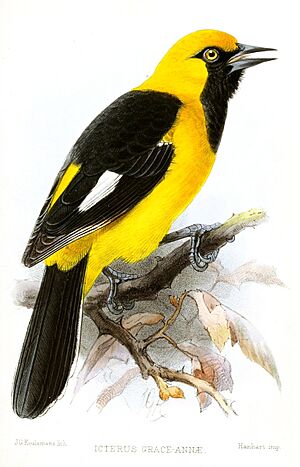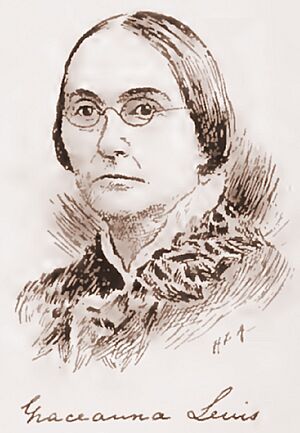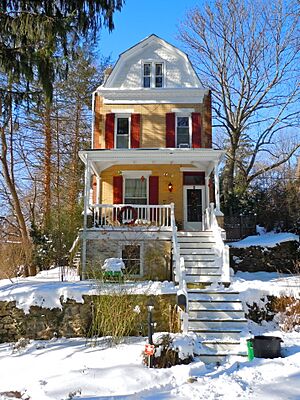Graceanna Lewis facts for kids

Graceanna Lewis (born August 3, 1821 – died February 25, 1912) was an American naturalist, illustrator, and social reformer. A naturalist is someone who studies nature. She was an expert in ornithology, which is the study of birds. Graceanna Lewis is remembered as one of the first important women scientists in America. She was also an activist who worked to make society better. She supported the movement against slavery, the temperance movement (which aimed to reduce alcohol use), and the women's suffrage movement (which fought for women's right to vote).
Contents
Graceanna Lewis's Life Story
Early Years and Education
Graceanna Lewis was born on August 3, 1821. Her family lived on a farm near West Vincent Township in Chester County, Pennsylvania. She was the second of four daughters. Her parents were John Lewis and Esther Fussell, who were members of the Quaker faith. Graceanna's family had a long history in Pennsylvania. Her ancestors came from South Wales in 1682, and one was a friend of William Penn.
Graceanna's father passed away when she was only three years old. Her mother, Esther, who had been a teacher, raised her and her sisters. Esther Lewis was very important in helping Graceanna love science. She observed stars and weather, and even noted when plants flowered. Her mother also showed her how to be a social activist. She helped enslaved people escape to freedom in Canada through the Underground Railroad. After her mother died, Graceanna continued this work. She secretly gave shelter to as many as 11 runaway enslaved people at one time.
Graceanna went to the Kimberton Boarding School for Girls in Kimberton, Pennsylvania. There, she learned about many natural sciences. These included astronomy (the study of space), botany (the study of plants), chemistry, and zoology (the study of animals). Graceanna was also very good at painting natural subjects. After finishing school in 1842, she became a teacher. This was one of the few jobs educated women could have back then. She taught botany and chemistry at a boarding school in York, Pennsylvania, run by her uncle.
Her Scientific Work
Another woman who inspired Graceanna was her friend Mary Townsend. Mary had written a book about insects, and Graceanna wanted to do something similar. In the 1850s, Graceanna moved to Philadelphia. There, she worked with a group of Quakers who were interested in science. In 1862, she met John Cassin, a leading bird expert from the Philadelphia Academy of Natural Sciences. She studied birds with him for five years. In 1867, Cassin honored Graceanna by naming a bird after her. It was called Icterus graceannae, or the White-edged Oriole.
From the mid-1860s, Graceanna started giving private lessons about birds in Philadelphia. Over time, her interests grew to include all parts of natural history. This meant she studied plants, animals, and even minerals.
In 1868, Graceanna published her book, The Natural History of Birds. She hoped it would be the first part of a much larger work. Sadly, her supporter John Cassin died in 1869. After this, she could not find a teaching job in science to continue her work.
Graceanna's big plans were also difficult because publishers thought her ideas were too complex for regular people. But they were not advanced enough for the scientific community. Graceanna was raised in a religious family. For most of her life, she did not agree with Charles Darwin's theory of evolution. She believed that God created a perfect and organized universe. Only in the 1890s did she start to accept some ideas about evolution. But she still believed that God guided the process. She did not think that random changes were part of how species developed. Instead, she thought evolution was a divine process to make species perfect.
Because of her strong religious beliefs and her lack of a university degree, Graceanna mostly gave popular lectures on nature. She also worked as a freelance scientific illustrator to earn money. Since this income was not steady, she took a teaching job at the Philadelphia Friends School in 1870. She stayed there for a year. On May 31, 1870, she was elected to the Academy of Natural Sciences. She had the support of two famous local scientists, Joseph Leidy and George Washington Tryon.
In 1871, Graceanna sold some family land. She used the money to pay for her research. She wanted to create charts that showed how plants and animals were related. But new information was coming out very quickly. She did not want to publish her charts until they were complete, so these projects were never finished.
Graceanna lectured twice at Vassar College, in 1874 and 1879. She applied for many teaching jobs at colleges. This included a professor position at Vassar. But because she did not have a college degree and because of sexism in academia, she could not get a university teaching job. Instead, Graceanna went back to teaching younger students. She worked at the Foster School for Girls in Clifton Springs, New York, from 1883 to 1885.
In 1893, the Pennsylvania Forestry Commission asked Graceanna to paint 50 watercolor pictures of tree leaves. These paintings were shown at the World's Columbian Exposition in Chicago. Graceanna's work was very successful. She won a medal and a diploma. Her paintings were also shown again at the 1901 Pan-American Exposition in Buffalo, New York, and the 1904 Louisiana Purchase Exposition in St. Louis.
She was a member of important scientific groups. These included the Academy of Natural Sciences in Philadelphia and the Delaware County Institute of Science.
Her Social Beliefs
Graceanna Lewis was very active in helping enslaved people escape before the American Civil War. She was part of a secret network that helped them find freedom. She also supported other social movements of her time. As a Quaker, she believed in peace her whole life. She was also active in the movement to stop alcohol sales in the United States. She was the Secretary of the Woman's Christian Temperance Union in Media, Pennsylvania. She also oversaw teaching about temperance in Delaware County.
Graceanna also worked hard for women's right to vote. In October 1875, she gave a speech called "Science for Women" at the Third Congress of Women in Syracuse, New York.
Death and Legacy
Graceanna Lewis spent her last years in her hometown of Media, Pennsylvania. She lived with her nephew, the artist Charles Lewis Fussell. She passed away there on February 25, 1912, at the age of 90, after having a stroke. She was buried at the Providence Friends Meetinghouse Burying Grounds.
Graceanna Lewis's writings and drawings are kept at Swarthmore College in Swarthmore, Pennsylvania. This collection includes her scientific papers and drawings. It also has an unpublished book she wrote about the Underground Railroad.
Images for kids
-
The white-edged oriole named ''Icterus graceannae' in Graceanna's honor






